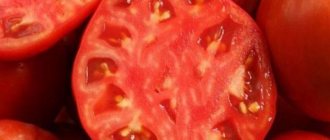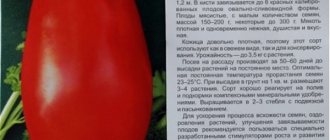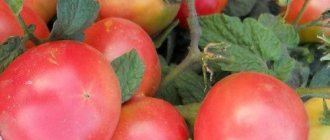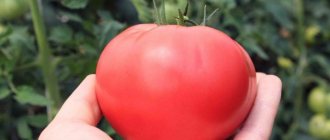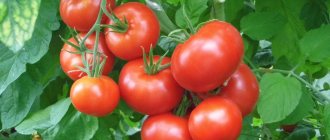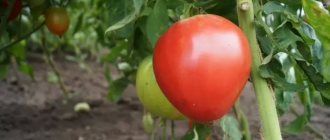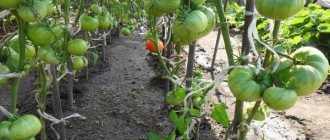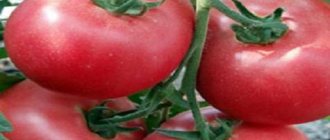Author's rating
Author of the article
Yakov Pavlovich
Professor, Head of the Department of Vegetable Growing
Articles written
153
In temperate climates, late tomatoes in the garden do not have time to ripen. Many summer residents have appreciated the merits of the early Valentina tomato and for many years now they have been happily growing an unpretentious variety, the oblong fruits of which are planted in clusters, canned whole in jars, and are suitable for collecting juice. Tomatoes are cultivated on an industrial scale; tomatoes with strong skin retain their presentation when transported over long distances.
Description and characteristics of the variety
This variety was created by Russian specialists from the Institute. Vavilova. It is listed in the State Register and is designed for open ground conditions.
Tomato Valentina from Sedek is a determinate plant with a limited bush height. As a rule, it is 50-70 cm. The bush is not standard, weakly leafy, semi-spreading. Needs support. The leaves look like potato leaves. Flowers appear after the seventh leaf and then after every first or second.
The variety is early ripening, tomatoes ripen in 102-105 days from the moment of sowing for seedlings. One fruit weighs on average from 80 to 100 grams, the skin is bright red or red-orange, and the shape is oval, plum-shaped.
The first harvest may produce round fruits; subsequent batches will take on the cream shape.
The pulp is fleshy and juicy. The skin is dense, making the variety optimal for canning whole fruits and pickling. In addition, it can be used for juices, sauces and any dishes.
Tomato Valentina - benefits
Experts include the main positive qualities of the Valentina tomato:
- good yield;
- excellent taste of ripe fruits;
- high resistance to most diseases;
- no pinching required;
- compact size of bushes;
- the harvested crop tolerates transportation well over long distances;
- The variety tolerates short-term drought well and is not demanding of care.
Video:
This vegetable plant has practically no disadvantages. It should only be noted that the bushes must be tied up during the period of ripening of the harvest.
Thanks to its positive qualities, the Valentina tomato is perfect for those summer residents who have little free time to care for vegetable crops in their beds - after all, even with a minimal investment of effort, this tomato produces good harvests.
Have you grown this variety of tomato? Leave reviews about the Valentina tomato for other vegetable growers.
Planting and care
Tomato seeds are sown for seedlings 50-55 days before planting in a permanent place. They dive when the plant produces its second true leaf.
Pre-hardened seedlings are planted in the ground. It is necessary to fertilize the soil, add peat, manure, sand for looseness, and prepare pegs for tying.
Regular watering with warm water is required at least once a week, fertilizing with mineral and organic preparations, weed and pest control, and also hilling of bushes.
Agricultural technology for growing tomatoes Valentina
In the conditions of the Urals and Siberia, it is better to grow tomatoes of the Valentina variety in greenhouses or greenhouses. Although the plant is adapted to these regions, it does not tolerate low temperatures well during the formation of buds and ovaries, so fruiting will deteriorate.
Seedlings should not be subjected to the picking procedure, because if the root system is injured, the seedlings then get sick for a long time, which negatively affects its further growth and fruiting. Therefore, it is better to immediately plant Valentina tomato seeds at an appropriate distance in a container.
The best varieties of tomatoes!
• Popular MAZARINE tomatoes • Yield variety VISIBLE-INVISIBLE
During the period of seedling growth, it is necessary to water them well, and also take care of sufficient lighting for the seedlings.
Transplantation of seedlings into open ground is carried out at the stage of 5-7 permanent leaves. The soil in the beds should be well heated and quite loose.
This plant is not demanding on the quality of the soil in which it grows.
But a nutrient substrate should be placed in the planting holes, which includes:
- sand;
- peat;
- rotted manure (taken in equal parts).
Further care for Valentina tomatoes consists of:
- regular watering (a little bit every two days);
- constant loosening of the soil;
- weed removal;
- preventive treatments against insect pests;
- when growing in greenhouses, they should be regularly ventilated so that the air humidity does not increase;
- After planting seedlings in open ground, for the first time they must be covered with a film covering at night to protect them from possible frosts.
Photos of Valentina tomatoes
Tomatoes: advantages and disadvantages
- Advantages of the Valentina variety:
- moderate growth;
- low maintenance, drought resistance;
- universal application;
- no need for stepsoning;
- good taste;
- resistance to diseases;
- keeping quality;
- transportability;
- high yield.
The only drawback of tomatoes is the requirement for a garter.
The Valentina tomato is grown by amateur gardeners, as well as small farms. The productive variety is valued for its unpretentiousness, productivity, and disease resistance.
Advantages:
- The variety is early, the first tomatoes in a state of technical ripeness are harvested after 95-98 days.
- High yield - up to 10-12 kg per 1 sq. meters.
- Good tomato taste.
- Suitable for whole-fruit canning.
- Excellent preservation of tomatoes during transportation.
- Keeping quality.
- The fruits do not crack even with long pauses in watering.
- Drought resistance.
- Resistance to major tomato diseases.
- Friendly return of fruits.
- Easy care.
These tomatoes are suitable for beginning gardeners, as well as for those who, due to work, cannot often visit the site. Disadvantages include the possibility of bushes being affected by late blight in some seasons (during rainy, stormy summers) and the need to tie up bushes growing in greenhouses.
The problem with diseases and pests is solved by carrying out the necessary preventive work. It is also important to follow basic agricultural techniques and the tomato will reward you with a good harvest.
The indisputable advantages of the “Valentina” variety are the following features:
- Compact low bush;
- Early fruiting period;
- The plant does not need pinching;
- Tomatoes tolerate minor drought well;
- Resistance to a large number of diseases;
- Very high yield;
- The fruits are well preserved during transportation;
- Excellent presentation of ripe tomatoes;
- Good keeping quality.
The only disadvantage of the “Valentina” tomato, which some vegetable growers note, is the need to tie up the bush.
Description of fruits
"Valentina" tomatoes have bushes with a small number of leaves and a spreading plant shape. The description and characteristics are similar to the Novichok tomato. Tomatoes are arranged on the stems in clusters; there are usually a large number of them of small size on one bush. The leaves are greenish-yellow, shaped like potatoes, their surface is corrugated. The fruits themselves are oval in shape, similar to the shape of plum fruits. Some gardeners have noticed that during the first stage of ripening, the fruits acquire a round shape, and then change to oval-round.
When ripe, tomatoes are orange-red in color, while unripe tomatoes are light green.
On average, the weight of one fruit reaches about 90 grams, and the yield from one bush can reach three kilograms.
The “Valentina” variety is used mainly for canning, preparing sauce, lecho and winter preparations.
Diseases and pests
Despite the high resistance to tomato diseases, the plant can still become infected if the rules of agricultural technology are not followed. Let's look at diseases and how to treat them:
- Late blight is a fungal disease. It is harmful and if it is not treated in time, you can lose one or more bushes of the plant. This disease has a damaging effect on those organs of tomatoes that are not in the ground, that is, on everything except the root system. Darkening and plaque appear on the plant and, as a result, rotting of such areas occurs. To avoid such a disease, it is necessary to carry out prevention by spraying with pesticides.
- Anthracnose of tomato. There are two types of this disease. In leaf form, the upper leaves wilt and the upper part of the central stem is exposed. The second type is damage to the fetus itself; it becomes covered with dark spots. For prevention, drugs based on Bacillus subtilis are used.
- Gray rot is common in many regions and deprives vegetable growers of more than half of their harvest. The fungal disease covers the entire area of the stem, provokes tissue necrosis, and causes a white-gray coating. The result is that the plant withers and dies. The infection is transmitted not only among this culture, but also from others. For such a disease, agrotechnical and chemical treatment measures are used.
- Powdery mildew develops most quickly in glass greenhouses. The pathogenic powdery mildew fungus, when accessed to a crop, affects almost the entire volume of the crop. It has several types of pathogens. One of these contributes to the formation of a white coating on the leaves. Another type appears as yellow spots on the upper parts of the leaves, after which a white powdery coating appears over the entire area of the leaf. Powdery mildew spreads faster when the humidity level is low and the temperature is low and the plant is rarely watered. To cure any type of fungus of this disease, sodium humate 0.1 percent is required.
- Stem cancer practically does not spread in glass greenhouses and open beds. But in film structures it develops at lightning speed and if the infection gets there, all the plants will die. The disease is expressed mainly on the stems. Brown, depressed spots appear at their bases, from which liquid oozes. Sometimes such spots may also appear on the “Valentina” fruits, followed by the process of mummification of the fruits and stems. Favorable conditions for the development of the disease are coolness, humidity and low temperature. When the plant is disposed of, the infection will remain on the seeds or plant debris. Growth regulators are used for treatment. People commonly treat stains on fruits with chalk paste.
- Septoria - if affected by this disease, you can lose more than half of the crop. This disease most often affects old leaves that are closer to the ground. As a result, these leaves begin to become covered with various spots, become deformed and subsequently dry out. Favorable temperature for the progression of the disease is from 15 to 27 degrees with high air humidity. But the “Valentina” variety has a gene that is resistant to this disease.
Reviews from gardeners
mopsdad1
the variety is very worthy. We tried it. Seeds are in great demand in stores. Ideal for preservation. Productivity is beyond praise.
Source: www.tomat-pomidor.com
Zhimburushka
Last year, on the advice of the seller, I planted the Valentina variety. I really liked it!! The bushes were about 50-60 cm. And the branches are strewn with tomatoes, like grapes. Cream.
Source: forum.prihoz.ru
Caring for tomatoes: features
Tomato Valentina is a non-standard determinate variety. They have limited growth and mature quickly. The bushes of such tomatoes are compact and have few stepsons. In open ground, such plants do not need to form a bush. But in greenhouses you should leave one stem.
In tomatoes, growth stops after the formation of an inflorescence, so a small shoot is left under the first one to continue growth. After the formation of two inflorescences and three leaves on it, it is pinched. The stems of the variety are reclining, so the bushes are tied to a wire with twine. These are the care features of the Valentina tomato.
The lower leaves begin to be torn off a month after the seedlings are planted in a permanent place. It is best to break off the leaves in the morning when the sun is shining. There should not be any of them below the first inflorescence when the fruits ripen on it.
The remaining leaves continue to be removed until the third inflorescence. This design of the bushes allows the fruits to ripen quickly and increases air exchange. In August, the main stem is pinched and all new shoots are removed.
Determinate tomatoes are most often characterized by simple agricultural technology, and although their yield indicators are somewhat lower than those of indeterminate varieties, they deserve attention.
The seeds of the variety are sown for seedlings in March, pre-soaking them in special solutions for disinfection and stimulation of germination.
Disinfection: seeds are dipped in a pink solution of potassium permanganate for 15 minutes, then washed thoroughly.
To improve germination, increase immunity: soaking tomatoes in a solution of Epin, Energen, infusion of wood ash, aloe juice.
Then the seeds are germinated in a damp cloth or gauze and sown in prepared boxes.
ON A NOTE!
Germinating seeds speeds up the emergence of seedlings.
After the first shoots of tomatoes appear, the boxes are exposed to light, the room temperature is reduced to 18ºC, and kept in this mode for about 4-5 days.
Then the temperature should be 22ºC... 24ºC until the end of growing the seedlings. Diving is mandatory; it is carried out when the tomatoes have 2-3 true leaves. They are transplanted into separate pots, and after 10-12 days they are fed with complex fertilizers.
Planting of seedlings - in May, the exact days are determined taking into account the weather and climate of the region.
Planting tomatoes
In open ground they plant 4-5 plants per “square”; in shelters they give the bushes more free space - 3 bushes each.
You may be interested in:
The soil should warm up to 13ºC... 14ºC, the beds can first be covered with black film.
Agricultural technology
All techniques for caring for the Valentina tomato are standard, the list includes:
- watering;
- loosening the soil (can be replaced by mulching);
- weeding;
- application of fertilizers.
Water the tomatoes regularly, trying not to take long pauses. For plants in the beds, there is often enough moisture from precipitation, but if the summer is hot, you will have to water it abundantly.
The water should be warm and settled. Neglect of these rules leads to the appearance of diseases in tomatoes, and even such resistant varieties as Valentina can “catch” the infection. After watering, greenhouses must be ventilated; in hot weather, windows and doors are opened.
There should be no weeds around the tomato bushes that “take away” moisture and nutrients from the plants. Mulching gives good results, saving summer residents from tedious weeding and tedious loosening.
Mulch is prepared from cut grass, bark, rotted compost, humus, and peat. Sawdust can be used, but it must first be thoroughly scalded with boiling water and sprinkled with humus or soil.
Organic matter and mineral fertilizers are used for fertilizing - there is a wide choice. Each gardener decides for himself which fertilizers to use, based on his capabilities and desires. Some make do with only organic matter, avoiding the use of “chemicals” on the site. In this case, it is necessary that the fertilizing be balanced in composition, and that the plants receive not only nitrogen, but also phosphorus and potassium in the required quantity.
The first feeding is 18-21 days after planting the tomatoes in a permanent place. To stimulate the growth of plants and the root system, diluted infusions of mullein (1:10) and bird droppings (1:15) are used.
The second feeding is after about two weeks, when mullein is used, as well as an infusion of wood ash. Mineral fertilizers are suitable for complex fertilizers, for example, nitrophoska. During the period of fruit ripening, tomatoes are provided with potassium and phosphorus (wood ash, superphosphate, potassium sulfate).
Watering with an infusion of fermented herbs (nettle, yarrow, comfrey) gives good results; only such a rich “cocktail” must be diluted with water 1:10.
During the season, tomatoes are fed 3-4 times, focusing on the condition of the plants. Do not forget about spraying on the leaves, for which compositions with boric acid, iodine, and potassium permanganate are suitable.
Diseases of this variety of tomatoes are not as dangerous as pests, so they dust the bushes with wood ash and plant fragrant herbs or flowers (marigolds, coriander) nearby. Typically, gardeners grow tomatoes in one greenhouse every year, without soil disinfection and crop rotation.
It is not possible to grow tomatoes in a new place every year, which means that green manure is sown in the fall, which disinfects the soil and enriches it with nutrients, replacing the top layer of soil. Such simple techniques will help protect tomatoes from the invasion of dangerous pests and ultimately save the harvest.
As preventive measures against diseases, they practice treating tomatoes with compounds containing garlic, ash, as well as Bordeaux mixture, the Barrier preparation. Spraying water with whey, as well as the drug Oxychom, helps against late blight.
Tomatoes are picked when they are green (technical ripeness) or already ripe on the bush. Harvesting unripe tomatoes allows you to increase the yield from the bush, especially since Valentina’s fruits ripen well indoors.
The Valentina tomato variety is recommended for cultivation in open ground or film shelters. The tomato is unpretentious, productive, suitable for all regions of the country.
How to grow seedlings
Sowing seeds for seedlings begins 2 months before planting in the ground. Seed material must be prepared for planting in order to prevent a number of diseases and increase the quantitative indicator of fruiting.
Seed preparation
The grains are laid out on the table and carefully examined one by one for visible damage. Grains suitable for sowing must be light in color, without bends or defects. They are then placed in a saline solution for 10 minutes. Those seeds that have sunk to the bottom are washed with running water and disinfected in a weak solution of potassium permanganate for 20 minutes.
To improve germination, seeds are soaked in a growth stimulator for 10 hours. Swollen grains can be sown in the ground.
Reference ! In addition to specialized drugs, melt or ordinary boiled water can serve as a growth stimulator.
Container and soil
The soil is prepared from a mixture of garden soil, humus, peat and river sand. River sand is added as a leavening agent for lightness . Peat contains many useful substances necessary for the full growth and development of seedlings. Such nutritious and fertile soil will accelerate the emergence of seedlings.
The resulting mixture is disinfected by steaming in an oven at a temperature of 50°C for at least 15 minutes or spilled with a hot solution of manganese. Soil disinfection destroys pathogenic flora, which ensures healthy growth of seedlings throughout the entire period.
You can plant in a common wooden box or in a separate container. Fill the planting container halfway with the prepared soil, adding the remaining soil as the seedlings grow. This technique helps to constantly receive the required amount of nutrients. Small drainage holes are made in advance at the bottom of the containers to allow excess moisture to drain into them.
Sowing
Seeds are sown to a depth of 1.5-2 cm with a distance of 3 cm from each other. Cover with soil on top, level, compact and lightly moisten with warm, settled water using a spray bottle. The sown containers are covered with film, thereby creating a greenhouse effect and left in a dark and warm room at a temperature of 24-26°C until germination.
Growing and care
When shoots appear, the film is removed and the containers are moved to a well-lit place on the windowsill. The temperature is maintained at 24-25°C. Daylight hours for seedlings are at least 14 hours. If the plants do not have enough daylight, they are illuminated with phytolamps.
Water moderately along the edge of the nursery with warm, settled water using a regular tablespoon. The main thing is not to overwater the sprouts, as excess moisture will negatively affect the young roots. After watering, the soil is loosened superficially with a wooden stick.
When 2 true leaves appear, the seedlings dive and are planted in separate containers. If the seeds are sown in peat pots, the seedlings do not need picking. The picking procedure involves shortening the main root by one third. Picking promotes the growth of lateral roots, due to which the seedlings grow vigorously.
Reference ! Throughout the entire period, seedlings do not need feeding.
2-2.5 weeks before planting, the seedlings are hardened off by taking them outside for 1 hour at a temperature of 16°C. Gradually, the time spent outdoors is increased to 14 hours. Simultaneously with daytime hardening, the night temperature in the room is reduced to 12°C.
Harvesting and application
Ripe vegetables begin to be collected in July-August. Fruiting is not extended, ripening is almost simultaneous, which significantly simplifies harvesting.
The purpose is universal: smaller tomatoes are used for whole-fruit canning, barrel pickling and marinades. Larger vegetables are processed into tomato products, from which excellent juices, pastes, adjika, ketchups and lecho are obtained.
Tomatoes are also ideal in any fresh dishes: summer salads, hot and vegetable stews, purees, they are used in a variety of snacks and sandwiches. Also used in baking with meat and for pizza.
Ripe vegetables are stored for several weeks and even months without loss of memory and can withstand long-term transportation, perfectly maintaining their presentation.



